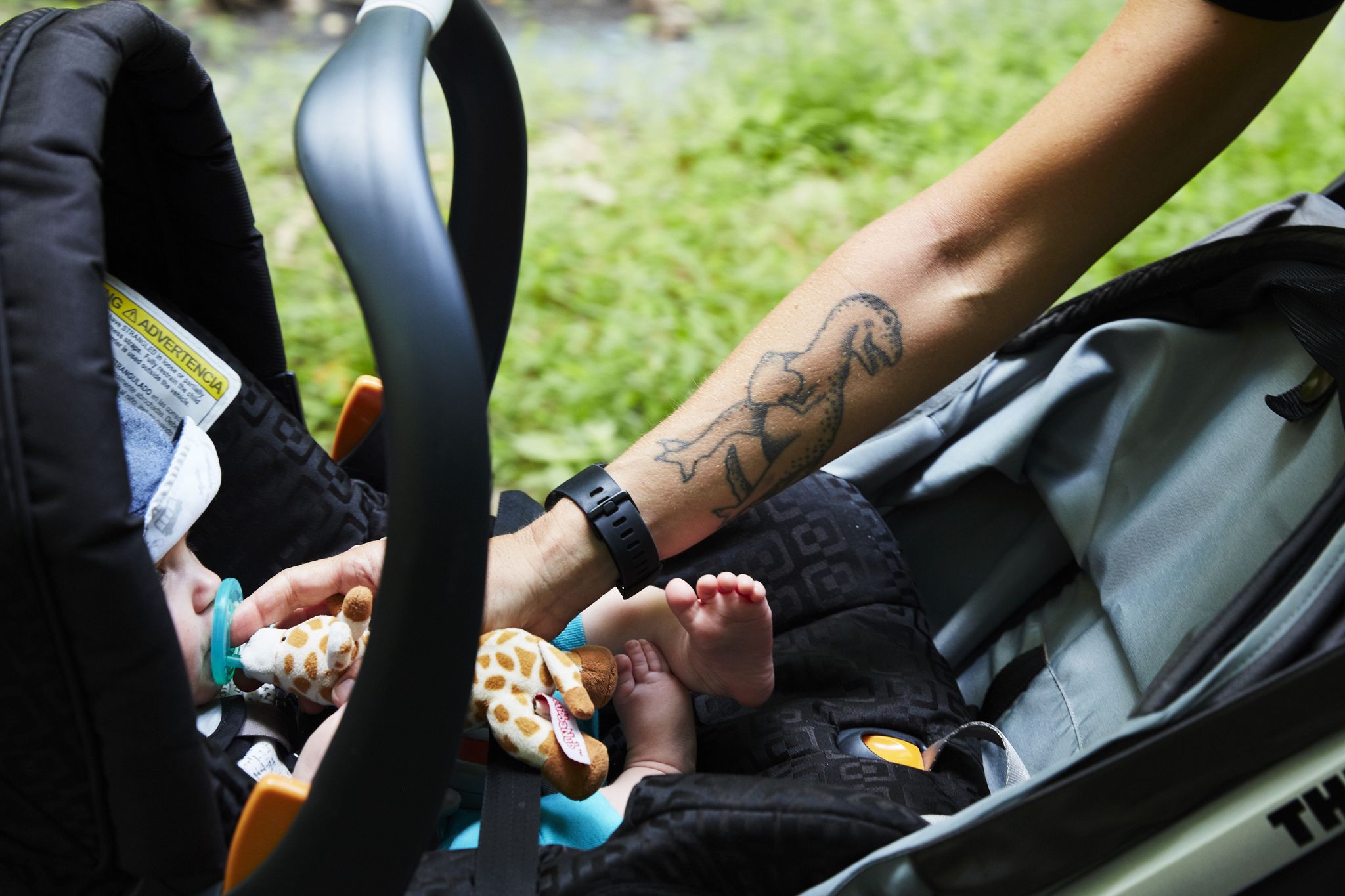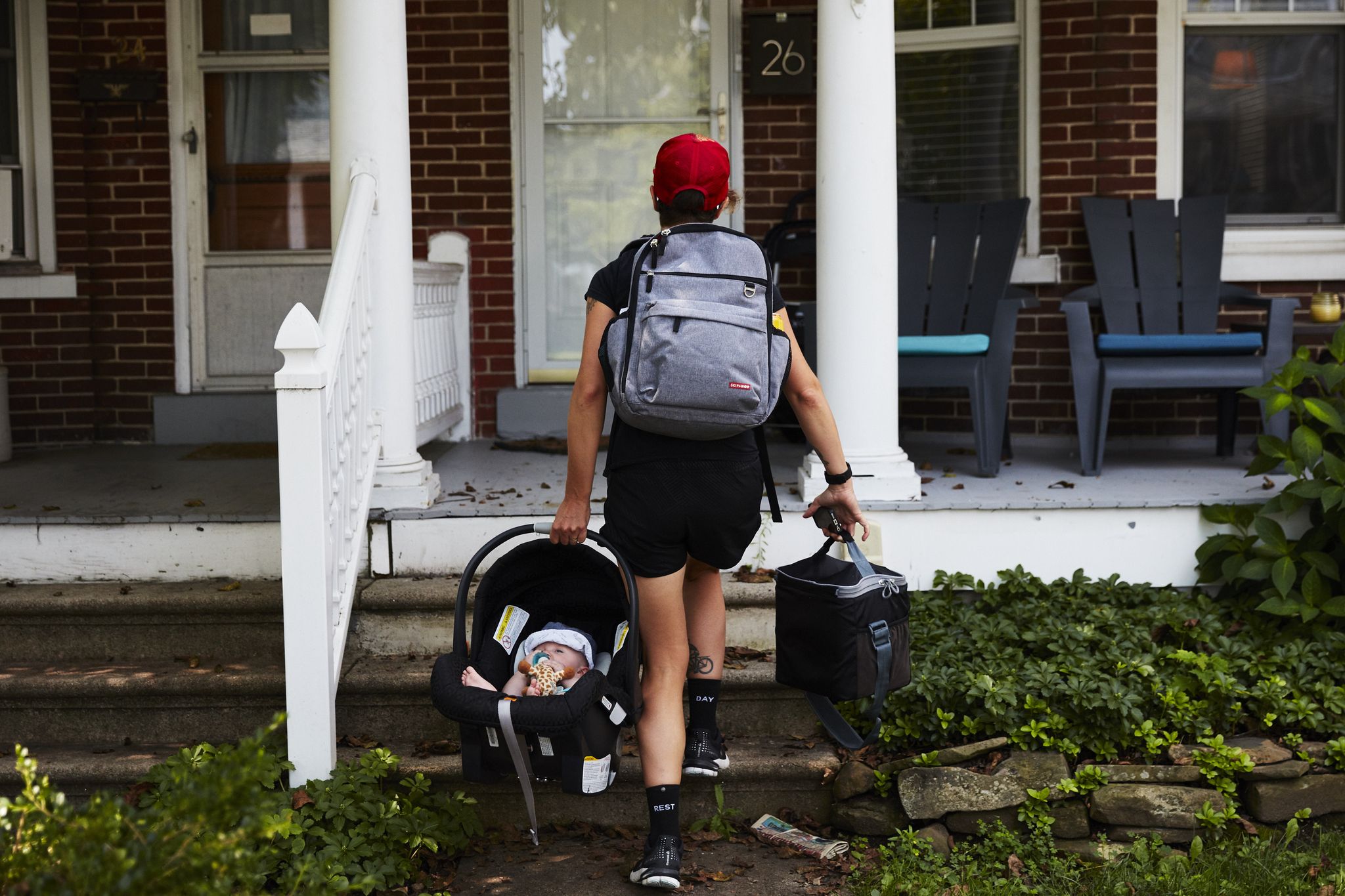It had been months since I felt strong on a run, but today sprinting felt easy. Five miles of trail passed through my system in a haze of runner’s high. My body felt shot through with adrenaline, like a deer that had finally managed to break eye contact with headlights. With each footfall, everything that was good about the world came into focus. I picked up speed.
An imaginary finish line waited ahead. I hurtled across it, doubling over from effort, and turned to high-five my running buddy. She wasn’t even winded. In fact, she didn’t even look awake—more like fast asleep in her carseat, hands wrapped around a stuffed giraffe. This was a good sign. We had finally achieved that elusive stroller running success.
I don’t know when it happened, but at some point I became obsessed with running strollers, long before I had any opportunity to use one. They were everywhere on my usual trail, with moms and dads of all speeds bounding along behind their contented offspring. Running with a kid seemed like running with a well-behaved pet, only better—here was a sidekick who could communicate back with you and someday even share your love of the sport.
The running stroller itself became my symbol of “having it all”—a way of making space for the self-care of running amid the crammed schedule and legendary sleep exhaustion of early parenthood. I had always dreamed of being a mom but feared it would mean letting go of the parts of my life that made me feel most like myself. And for more than a decade, the miles I put in every morning had been the brightest part of my day, at the center of my sense of peace with the world. I couldn’t envision any way to maintain that level of time commitment and endorphin addiction while caring for a child. Gliding down a trail behind a running stroller was the only image my mind kept coming back to.
Bob Revolution Flex Runner’s World gear roundups, weighing the pros and cons of each model for when I’d eventually own one. Size, weight, cost, hand brakes, sun canopies, shocks. There were plenty of factors to consider without losing sleep on the one that held the most weight: I was nowhere close to having anyone to actually put in one.
Health & Injuries “Shoes & Gear.” No “I don’t feel ready, but I guess here we go!” Running in the Cold “Surprise! What you thought was the aftermath of a massive burrito actually has a heartbeat and fingernails now!” Advertisement - Continue Reading Below really want children when your bodies aren’t designed to make them together—just one of the reasons I like to think my people make such great parents.
Despite these higher barriers to entry, for my wife and me, having kids was a no-brainer. We had discussed the issue on one of our first dates, each prepared to reject our initial spark if the other wasn’t interested. But it took almost five years into the relationship before we felt like our lives were stable enough to pull the baby-making trigger. We didn’t know any other queer parents and had no idea how big of an ordeal it might be. Fertility treatments and IUI (intrauterine insemination) seemed like the best course of action. As our first appointment neared, I could hardly wait, certain that my body was just waiting for the chance to get knocked up. I waved every time I passed a pregnant runner on the trail, feeling smug that I would soon find myself among their glowing ranks.
But our first fertility appointment was a three-hour wakeup call. At 36, I was of what doctors call “advanced maternal age” and any pregnancy that might happen for me would bear the unfortunate title of a “geriatric pregnancy.” I knew I didn’t have infinite time to get pregnant, but 40 was the deadline I had always carried in my head. I had always just assumed a lifetime of gayness was the only thing between me and a minivan-sized brood.
The experience of running out of time to have a baby is a weird one because friends and family so frequently reassure you there’s all the time in the world, citing celebrities who gave birth until midway through their fifties. A fertility doctor, on the other hand, will give it to you straight within 30 seconds of peering into your cervix: You basically have one or two eggs left, ping-ponging around in a cobweb-filled cavity. Soon you might have just one tired, old egg remaining, nestled inside your ovary crocheting pillows and watching This Top-Rated Jogging Stroller Is Amazons Deal of the Day for eternity. It’s a hard image to align with your idea of yourself—this wild-haired, marathon-running badass who loves waterslides and comic books and still occasionally gets carded in low-lit restaurants. But even those of us with too much working knowledge of Marvel Universe continuity can have a limited fertility window.
My body, strong and lean from daily running, had for so long felt under my control. Now I was powerless to make it do the one thing I always assumed it had been built for. I began fertility treatments. I ate healthy,took vitamins, drank less, and slept more. I stopped running and gained weight at the doctor’s request, and underwent month after month of pills and shots that left me bloated and emotionally shattered when I faced each inevitable negative pregnancy sign. Without 50 miles of running endorphins in my system every week, I was a constant sobbing mess from hormones designed to imitate the symptoms of pregnancy without any sign of a future baby.
And babies are everywhere when you can’t get pregnant. Old friends start calling with big news. Facebook becomes a digital photo album of ultrasounds. “It’s in the water!” became the joke around my office after two coworkers in a row announced their pregnancies. On a flight home from visiting my sister-in-law’s new infant, the attendant was so awed by how many babies were on the plane that he announced the total over the loudspeaker (23!). I couldn’t stop picturing the plane literally full of babies—the inevitable, but non-deadly crash caused by a tiny-armed baby pilot, babies in every row having to help other babies onto that inflatable escape slide, everyone flailing excited little fists at the dangling oxygen masks. I was surrounded by infant abundance, but my own baby felt so far away.
Curled up in an emergency room bed with ruptured ovarian cysts after a failed IVF retrieval, I finally gave up on the idea that I would ever get to be that happy pregnant runner, lighting up the trail with an aura of maternal warmth. I would never be pregnant at all, and possibly never even a parent. Maybe I would spend the rest of my life alone, idly watching my marriage implode from the financial blow of so many fertility failures. I stopped making eye contact with the parents pushing strollers through the park, and avoided friends who had recently announced pregnancies. Everything seemed so easy for them, including running. I was much slower now after nearly a year on a hormone regimen that amounted to reverse doping.
Every infertility story I’ve read ends with a baby—that seems to be the unwritten rule. When my wife got pregnant, it was not the happy ending to our saga you’d imagine. She loved kids, but never wanted to carry one, and felt deeply resentful to have her backup uterus called up from the bench. And I struggled with envy that she had the opportunity to experience a rite of passage I would never know. We argued over whether to do the traditional pregnancy things, like newborn classes. I wanted to take them, she didn’t—though we both laughed at the image of me attending alone without a bump or third-trimester spouse for context. And then there were darker, more selfish concerns: Would I feel the same connection to a non-biological child? “Stock up on sleep now because it’s curtains for you when the baby gets here,” well-intentioned parents at my office warned me, as if I weren’t already tossing all night from the stress.
Finally, it was time. After nine months of nausea, discomfort, and stubbornly refusing to “glow,” my wife had to be induced for pre-eclampsia. The birth was as beautiful as it was horrific to watch. Millie was here. The nurses wrapped her in a swaddle as airtight and snug as a Starburst wrapper, and lowered her into my arms. And from the moment she stared up at me, I knew without question she was mine. I looked down at her until my neck muscles seized up, thought of all the adventures we’d have together, and cried. You better believe I pictured the two of us passing all the other babies on the trail.
On the day Millie was finally old enough to ride in the running stroller, we got up early (her idea, of course) and walked to the start of the trail. I tried to keep both hands on the handlebar as we lurched into motion. Immediately, everything felt awkward and wrong. This was more like flailing than running, and not at all like the effortless glide I had witnessed in so many other stroller runners. I looked more like a contestant on the old game show Supermarket Sweep—hands in a death grip on the handle of a shopping cart, frantically pitching my body forward in a desperate quest to grab as many diapers and blocks of cheddar as possible before the clock ran out. Even Millie looked uncertain from her cozy nest inside the stroller’s carseat adapter. I hope you know what you’re doing, her little eyes seemed to say.
Stroller running was not what I expected. It turned out, nothing was what I expected, not pregnancy, parenthood, or shuttling a baby down a trail. Maybe I was crazy to think anything would be easy for me. Running never had been—it took me years before I could run even a mile without shotgunning pulls from an inhaler, and decades to build up to where it gave me any sort of a high. I started to realize things would always be really fucking hard and maybe that was just a huge part of what made doing them worthwhile. It was like knowing you were bound to hit the wall toward the end of every marathon, and still feeling the need to keep lining up.
On my next few runs with the stroller, I worked on my technique of running with just one hand on the handlebar so that the other could pump furiously to the side. I slowed to a pace that could better be described as “loose shuffling” than running, and tried to focus on distance over speed. At least Millie was making it look easy, fast asleep with one socked foot poking out from the suncover, unbothered by my abysmal form. Two women running together with strollers waved as they bounced past in the opposite direction. “They look like real moms,” I thought. “Wait, I probably look like a real mom,” I thought next, before realizing I actually didn’t care whether I did or not. I smiled and picked up speed, remembering how I’d once worried if I didn’t look a real runner in the same way.
Millie slept on, holding her little giraffe, oblivious to all the therapeutic breakthroughs our run was giving me. We weren’t ever going to be fast together, but we would keep at it.


















